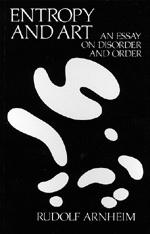Last update: May 2004
BACK
Publications in Visual Arts & Representation :
-
Arnheim, Rudolf:
-
Art and Visual Perception: A Psychology of the Creative Eye,
1974.
-
Entropy and Art - an
Essay on Disorder and Order, 1971.
-
New Essays on the Psychology of Art, 1986.
-
The Power of the Center: A Study of Composition in the
Visual Arts, 1988.
-
Leyton, Michael:
-
Willats, John :
BibTeX references.
Art and Visual Perception:
A Psychology of the Creative Eye
Rudolf Arnheim (1904- )
University of California Press, 1974
 PDF file of Notes/extracts
from Arnheim's masterpiece (in progress).
PDF file of Notes/extracts
from Arnheim's masterpiece (in progress).
Bibliography @ LookSmart:
-
Sciences > General Science > Famous Scientists > Psychologists
> Rudolph Arnheim
Bibliography at Leonardo on-line:
Biography : "The
Little Owl on the Shoulder of Athene".
From Verstegen, Ian
(http://astro.temple.edu/~iversteg/Arnheim.html) :
-
"Rudolf Arnheim is one of the most important scholars to advance a
psychological approach to aesthetics. After training in experimental
psychology at the University of Berlin in the 1920s, he did pioneering
work on film and radio in Germany and Italy. Fleeing Nazism in Germany
and fascism in Italy, he settled into American academics where he
applied his training in gestalt psychology to art. He taught most of
his career at Sarah Lawrence College (1946-1968) while he was also on
the Graduate Faculty of the New School for Social Research. During this
period he wrote Art and Visual Perception (1954). In 1968 he was
invited by Harvard University to occupy a chair in the Psychology of
Art. At Harvard he wrote Visual Thinking (1969), a more broadly based
exploration of thinking in general. Finally, Arnheim retired to Ann
Arbor, Michigan, where he was visiting professor at the University of
Michigan. Since his "retirement," Arnheim has written tens of
articles and several books - continuing to publish up to this very
day."
-
More on Arnheim: "The Thought, Life and Influence of Rudolf
Arnheim" :
Entropy and Art
an Essay on Disorder and Order
Rudolf Arnheim
University Of California Press, Berkeley - Los Angeles - London, 1971

ToC
I
|
II
|
-
Useful order
-
Reflections of physical order
-
Disorder and degradation
-
What the physicist has in mind
-
Information and order
-
Probability and structure
-
Equilibrium
-
Tension reduction and wear and tear
-
The virtue of constraints
-
The structural theme
|
Order in the second place
The pleasures of tension reduction
Homeostasis is not enough
A need for complexity
Art made simple
Call for structure
Notes
Plates
Bibliography
|
Text on-line:

Reproduction of Figure 3 (p.35).
John Willats
Published in Princeton, N.J. : Princeton University Press, 1997.

Table of Contents
-
Chapter One: Introduction
PART I: DRAWING SYSTEMS
-
Chapter Two: Projection Systems
Chapter Three: Topology and Extendedness
PART II: DENOTATION SYSTEMS
-
Chapter Four: Regions as Picture Primitives
Chapter Five: Line Drawing
Chapter Six: Optical Denotation Systems
PART III: PICTURE PRODUCTION
-
Chapter Seven: Separate Systems?
Chapter Eight: Picture Production as a Process
PART IV: THE FUNCTIONS OF REPRESENTATIONAL SYSTEMS
-
Chapter Nine: Representing Shape
Chapter Ten: Flattening the Picture Surface
Chapter Eleven: Anomaly in the Service of Expression
Chapter Twelve: Investigating the Nature of Depiction
PART V: CHANGES IN REPRESENTATIONAL SYSTEMS OVER TIME
-
Chapter Thirteen: Children's Drawing Development
Chapter Fourteen: Historical Changes
Synopsis
In this text, the author presents a radical theory of pictures. To do
this, he has developed a precise vocabulary for describing the
representational systems in pictures - the ways in which artists,
engineers, photographers, mapmakers and children represent objects. His
approach is derived from recent research in visual perception and
artificial intelligence and he begins by clarifying the key distinction
between the marks in a picture and the features of the scene that these
marks represent. The methods he uses are thus closer to those of a
modern structural linguist or psychoanalyst than to those of an art
historian. Using over 150 illustrations, Willats analyzes the
representational systems in pictures by artists from a wide variety of
periods and cultures. He then relates these systems to the mental
processes of picture production and shows how Greek vase painters,
Chinese painters, Giotto, icon painters, Picasso, Paul Klee and David
Hockney have put these systems to work. The book is also concerned with
why artists from different periods and cultures have used such
different systems and why drawings by young children look so different
from those done by adults. Willats argues that the representational
systems can serve many different functions beyond that of merely
providing a convincing illusion. He then concludes that art historical
changes, and the developmental changes in children's drawings, are not
merely arbitrary, nor are they driven by evolutionary forces; rather,
they are determined by the different functions that the
representational systems in picture can serve.
BACK
Page created & maintained by Frederic Leymarie,
1998-2004.
Comments, suggestions, etc., mail to: leymarie@lems.brown.edu
 PDF file of Notes/extracts
from Arnheim's masterpiece (in progress).
PDF file of Notes/extracts
from Arnheim's masterpiece (in progress). PDF file of Notes/extracts
from Arnheim's masterpiece (in progress).
PDF file of Notes/extracts
from Arnheim's masterpiece (in progress).

